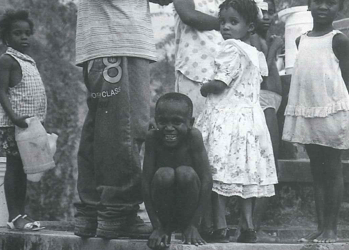Doctors in the Field
Mission to Honduras

Clockwise: A mother waits for medicine; Honduran medical stu- dent Jairo Caballero examines his chart: U.S. volunteers set up the schoolhouse clinic.
Zamorano, Honduras – The family of eight rural villagers crowded on a narrow wooden school bench in the improvised clinic. They had traipsed from their tiny village, almost two hours more into the mountains, to the schoolhouse-clinic in the Honduran hills a half-hour ride and a world apart from the prestigious Zamorano College.
Medical brigade volunteer Dr. Weijen Chang asked them patiently through an interpreter what the problems were. And they were multifold. The bad colds in two of the children turned out to be pneumonia. And then there were the problems with asthma, headaches, machete wounds, malnutrition, and parasitic infections. Chang gave them as much sage medical and practical advice as he could muster, and then sent them to the “meds” table staffed by Linda Jo Stern, the director of the Brigham and Women’s Hospital Medical Mission to Honduras, and Reyner Maradiaga, who works in rural development for Zamorano in the surrounding Yeguare region.
At the improvised pharmacy, the family could pick up medicine, collected by the mission for this purpose, and resume its hike home.
For five days, Chang and his colleagues? doctors, nurses, midwives and dentists, accompanied by Honduran dentists and medical students?listened to the concerns of the poorest of Hondurans and tried to do something to at least alleviate some of the problems.
“It’s a level of involvement that’s difficult to replicate,” said Dr. Edwin Rock, a medical resident at Brigham and Women’s Hospital, a Harvard teaching hospital.
The Medical Mission is in its third year. All the brigade members take vacation time and pay their own way, volunteering to serve the poor region even further devastated by Hurricane Mitch two years ago. Mitch destroyed roads, bridges, water supplies, and agricultural crops. The needs are immense. When a medical student told a mother she should boil her water, he received a frustrated answer: there isn’t enough wood left to make fires to boil water. A doctor cautioning a patient to eat more vegetables received a stare: “It isn’t the season for vegetables.”
It’s a two-way street. Villagers receive health care and medicine and even such simple needs as dandruff shampoo and aspirin. Doctors and medical students come back with a more thorough understanding of the complex needs and interwoven social issues of health, sanitation, and education., as well as some practical training in tropical diseases and ailments they might not see in Boston. One might even call the brigades a three-way street at this point, since the brigade collaborates with the Honduran Ministry of Health and works together with Honduran dentists and medical students.
“This has been an amazing experience for me,” said Jairo Caballero Valle, a fifth-year medical student at the Honduran National University in Tegucigalpa, who was on his second brigade. “It’s been a chance to work alongside U.S. doctors and to learn something about another side of my own culture too.”
Six brigades a year go from Boston to rural Honduras to provide basic medical and dental care to the villagers, whose average income is $3 a day per family, according to Peter Doyle, who runs Zamorano’s rural development department.
“Families are getting poorer because of the lag effect from Mitch,” he observed. “That’s why you get 2000 people attended by these brigades. Health and tourism are very critical for rural development, and these are areas where Zamorano hopes to have more impact.”
Zamorano hopes to strengthen its formal relationship with the brigades and to work on issues of health education and structural reforms, as well as medical delivery, Doyle said. The college, primarily an agricultural school, received three years of funds from the Kellogg Foundation in 1997 to strengthen its social and community projects. The project was called UNIR?the Spanish word for “united.”
“We’re trying to build on top of what we started with UNIR ,” said Doyle. “And health is an important cornerstone.”
Stern, the energetic director of the brigades, who also is the executive director of the Southern Jamaica Plain Health Center, made her first trip to Honduras in 1994. The missions were an outgrowth of a Falmouth-based organization called Cape CARES. Stern partnered with Dr. Helen Burstin of Brigham and Women’s Hospital, Zamorano, and Partners In Health to extend the project.
“The goal now is to provide resources, support, and training for the Honduran health care providers so they can serve the people of their country,” she commented.
She now wants to extend the project even further, hoping to raise funds for a full-time commitment to the project to work more intensively on its health education and community development aspects.
“The medical brigades are a challenge, an opportunity for learning and service, and they make a small but real difference in the world,” commented Stern on the July brigade to Honduras. “It’s much different to see the reality down here than telling people about the limited resources in a conference room in Boston.”
Fall 2000
June Carolyn Erlick is publications director at the David Rockefeller Center for Latin American Studies.
Related Articles
Latino Mental Health
What brings you in to see me today?” This is the typical question asked of new patients during a psychiatric evaluation in a Boston clinic. When asked of a Latino patient, however, the answer…
Health: the Hope of Haiti
At no time have I felt more vital than in serving at Partners In Health (PIH), and seldom more needed than in places like Haiti. In the Haitian people, as well as in every other country that PIH serves, we find an…
Whither Equity in Health?
A waiting room in a charity clinic in rural Haiti. It is a humid afternoon, and huge drops of warm rain are starting to fall. A young woman is watching as her ten-year-old son, Dominique, clutches…




